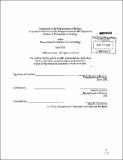Induced pluripotency and reprogramming by defined factors
Author(s)
Carey, Bryce W
DownloadFull printable version (19.30Mb)
Other Contributors
Massachusetts Institute of Technology. Dept. of Biology.
Advisor
Rudolf Jaenisch.
Terms of use
Metadata
Show full item recordAbstract
The process by which the totipotent zygote undergoes development into an adult organism using a single genome is the foundation for epigenetics and cellular differentiation. Somatic cell nuclear transfer experiments (SCNT) provided unequivocal proof of nuclear equivalency between adult somatic cells. However the molecular mechanisms of somatic cell reprogramming have remained largely a mystery. Recent advancements in epigenetic reprogramming by defined factors provide new opportunities to explore factors that regulate induction of pluripotency in somatic cells. Nuclear reprogramming by SCNT occurs in an 'indirect' manner by unidentified components within oocyte cytoplasm and requires the destruction of embryos. The introduction of induced pluripotent stem cells (iPS cells) and 'direct' reprogramming methods created a tractable system to both study of the process in vitro and potentially derive personalized pluripotent stem cells free of the practical and ethical concerns surrounding embryonic stem (ES) cells and SCNT. Herein we study mouse somatic cell reprogramming by defined factors and develop novel tools to compare the induced pluripotent state to the gold standard of pluripotency, ES cells. First, we designed reprogramming vectors that minimize the number of viruses required to generate iPS cells, yielding pluripotent cells with minimal genomic alterations from reprogramming factors. This allowed the creation of transgenic "reprogrammable mouse" strains after gene targeting in ES cells, providing a renewable source of somatic cells that can be induced to pluripotency by addition of a drug. In addition we can easily introduce or mate these strains to study unique genetic variants during reprogramming. Third, we study factors that influence the induced pluripotent state, specifically how to generate pluripotent cells with all properties of embryonic stem cells including derivation of "all iPS cell mice" by tetraploid complementation assays. In contrast to previous reports, we find the majority (- 80%) of iPS cell lines derived from adult somatic cells of varying organs contain the developmental potential of ES cells. This outcome correlated with high expression of Oct4 and Klf4 and low expression of Sox2 and c-Myc during reprogramming. In addition we report that adult mice derived from iPS cells are healthy and do not develop tumors. Together these results suggest in vitro reprogramming to pluripotency by defined factors holds great promise for regenerative medicine.
Description
Thesis (Ph. D.)--Massachusetts Institute of Technology, Dept. of Biology, June 2011. "June 2011." Cataloged from PDF version of thesis. Includes bibliographical references.
Date issued
2011Department
Massachusetts Institute of Technology. Department of BiologyPublisher
Massachusetts Institute of Technology
Keywords
Biology.